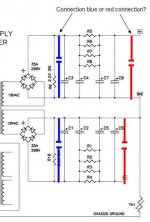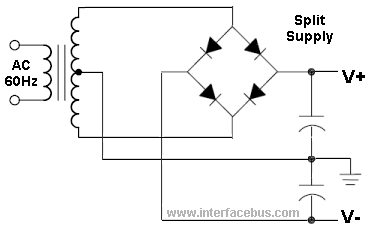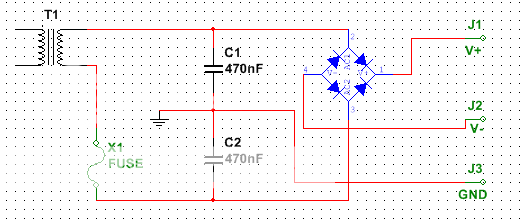... the first cap after the diodes, ... that'll suffer quite severe current pulses without complaint -...
Hi all,
So we can espect a sorter useful livespan for first caps bank , then for second Bank after Resistor, If same time caps are used, due to work harder?
E.g. if we expect a useful lifespan of 8 years in second bank, can we expect about alf time for the first bank?
If so, Reducing the first bank will not worsen this problem?
Thanks
Last edited:
Carlomar - The life of the capacitors is going to primarily depend on the operating temperature of those caps. Not the rating, but the ambient temperature inside the case. You will get more life out of all the caps, first and second bank if you have many vent holes on the bottom and top of the chassis to promote good airflow in the case. Also keep the amp exterior away from obstructions.
That will help more than capacitor selection.
That will help more than capacitor selection.
Thanks 6L6,The life of the capacitors is going to primarily depend on the operating temperature of those caps. Not the rating, but the ambient temperature inside the case. ...
I know that, but my question goes in that diretion.
Due to warder work of first caps, it tendency to heat more tham second caps Bank. I am not refering to heat from chassis, but to heat from cap worK.
If we reduce the first caps bank, will it heat even more. I know it depens of the cap type and grade.
I think i remender read some think about caps heating due to poor capacity and hi corrent riple in one F5 tread.
I think i remender read some think about caps heating due to poor capacity and hi corrent riple in one F5 tread.
there was one member having this problem, yes
not all know that there are different cap types, also among the Pana
quite many actually
and not all have the experience needed to choose the right type in that cap jungle
even the similar looking snap in caps may vary from 2A to 6A
Im now looking at much smaller caps(different purpos)
some have up to 4A ripple current specs
and other of exact same size could have only 500mA
though, I do have 'small' Rifa 4700uf caps with 30A, at 40 degr temperature
but 6L6 is right
your box design and layout could make a difference
Use your best capacitors after the R of the rCRC.
Ensure the caps before the R can take the ripple current that will be imposed on them.
Many smaller capacitors usually run cooler than a few big capacitors in this first C position.
Use cheap commercial caps for that first C. They are so far removed from the Audio Signal That comes later that they have virtually no effect on Audio Quality. But they MUST operate as capacitors for the first stage filtering rC to be effective. Fakes and undersized are no good here.
Back to the caps after the R:
These supply the LF current to the amplifier. They should be adequately sized to meet that LF current demand and they should be good for Audio. That does not mean they need to be exotic AudioPhool types, but they must be good capacitors that can release charge when demanded.
These 10 caps are original, not fakes are Vishay BC 15.000uF.
Both caps have left over the bank turned on in the 2nd, the F5 was connected any warms two hours, it was more to not stay 2 caps on the shelf.
They were connected as the schema in Red...
Attachments
Hi there!
I want to start an F5.
Can I use instead of usual MBR's for the diode bridge, use IXYS High Current, Fast Recovery Epitaxial Diodes Freds, 2 x 30A 600V? And do I use than 2 of them? I have some of them from a damaged amp from the junkyard. Thanks for the answer. Teake
I want to start an F5.
Can I use instead of usual MBR's for the diode bridge, use IXYS High Current, Fast Recovery Epitaxial Diodes Freds, 2 x 30A 600V? And do I use than 2 of them? I have some of them from a damaged amp from the junkyard. Thanks for the answer. Teake
is it possible to build a power supply for the F5 with a transformer that have only one secondary. I already have one 700va 
I saw some schematics that create a virtual 0V and have symetrical supplly using only one secondary. Is there any risk at this power ?
regards AQ
I saw some schematics that create a virtual 0V and have symetrical supplly using only one secondary. Is there any risk at this power ?
regards AQ
Thank you for your replies
The transformer has 3 secondaries, 10v at 1.5A, 20v at 1A and finally 45v at 15A.
As zen mod said, I found into the quad 606 service data manual this :
I'm thinking of connecting these outputs to the psu board of diyaudio store: V+to D+, GND to D- and D+1, V- to D-1, as the gnd is already created.
Do you think it can run well ?
regards AQ
The transformer has 3 secondaries, 10v at 1.5A, 20v at 1A and finally 45v at 15A.
As zen mod said, I found into the quad 606 service data manual this :
An externally hosted image should be here but it was not working when we last tested it.
I'm thinking of connecting these outputs to the psu board of diyaudio store: V+to D+, GND to D- and D+1, V- to D-1, as the gnd is already created.
Do you think it can run well ?
regards AQ
I would suggest Pnasonic FR
25V, 3300uf
can size 16x25mm, ESR 14 mohm(0.014)
very impressive 3.8A ripple current
buying 100 of them wouldn't cost much
but to mount and wire them all...
btw, where are the limits regarding lowering ESR and increasing current handling, by paralelling caps ?
(I suppose it takes other considerations than just simple math)
Actually, if we parallel them the best way, then the math gets really simple (because everything gets so peachy that the math basically ceases to be an issue).
I will admit that I have been exploring some ideas abouit paralleling caps. But, even better than that, I found somebody who already knows far more than I do about it!
Anyway, here is a link to the best summary and solution that you're likely to find (this easily
http://www.diyaudio.com/forums/chip-amps/224914-lm3886-component-selection-3.html#post3282640
Yes, you have to go to each of those links. But then you, too, will know...!
I was kind of kidding about the math. "WE" don't have to worry much about it, here. But if an engineer did this at work or for a commercial product, then it would be very important. You will read about it very briefly, if you follow the link and the sublinks, but it involves determining the optimal shape of an array of capacitors connected between two conductive planes, so that the current flowing between some edge and some other edge (of the planes) "spreads out" well-enough to utilize all of the capacitors.
The reason I mentioned that is because you were wondering about "limits". Well, one of the limits, for paralleling capacitors, is how many you can fit where, while still increasing the beneficial effects by enough to matter, and to be worth doing, as the number of caps is increased. And it turns out that certain shapes of arrays of parallel caps are better than others. And definitely certain interconnection methods are better than others. Any limitations will arrive much more quickly if solid conductive planes are not used, I believe. But just read the links. The (MEASURED!) impedance numbers are extremely impressive. (And if we use enough parallel caps, then their individual current-handling ability becomes much less important, too.)
Last edited:
- Home
- Amplifiers
- Pass Labs
- F5 power amplifier


